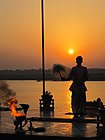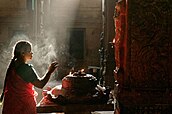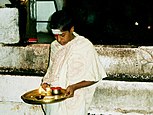Puja (Hinduism)
Puja, or prayers, in different forms.
|
|||||
Diverse forms of puja
|
|||||
Pūjā or Poojan is a prayer ritual performed by Hindus to host, honour and worship one or more deities, or to spiritually celebrate an event. Sometimes spelt phonetically as pooja or poojah, it may honour or celebrate the presence of special guest(s), or their memories after they pass away. The word pūjā (Devanagari: पूजा) comes from Sanskrit, and means reverence, honour, homage, adoration, and worship. Puja rituals are also held by Buddhists, Jains and Sikhs.
In Hinduism, puja is done on a variety of occasions, frequency and settings. It may include daily puja done in the home, to occasional temple ceremonies and annual festivals, to few lifetime events such as birth of a baby or a wedding, or to begin a new venture. The two main areas where puja is performed are in the home and at temples to mark certain stages of life, events or some festivals such as Durga Puja and Lakshmi Puja. Puja is not mandatory; it may be a routine daily affair for some Hindus, periodic ritual for some, and infrequent for other Hindus. In some temples, various pujas may be performed daily at various times of the day; in other temples, it may be occasional.
Puja varies according to the school of Hinduism. Puja may vary by region, occasion, deity honored, and steps followed. In formal Nigama ceremonies, a fire may be lit in honour of deity Agni, without an idol or image present. In contrast, in Agama ceremonies, an idol or image of deity is present. In both ceremonies, a diya or incense stick may be lit while a prayer is chanted or hymn is sung. Puja is typically performed by a Hindu worshipper alone, though sometimes in presence of a priest who is well versed in procedure and hymns. In temples and priest-assisted event puja, food, fruits and sweets may be included as offerings to the deity, which, after the prayers, becomes prasad – blessed food shared by all present at the puja.
Both Nigama and Agama puja are practiced in Hinduism in India. In Hinduism of Bali Indonesia, Agama puja is most prevalent both inside homes and in temples. Puja is sometimes called Sembahyang in Indonesia.
...
Wikipedia








